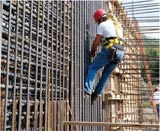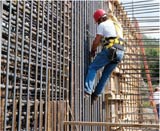
Living on the Edge
The only fail protection PPE requirements that remain constant regardless of the type of work being performed are comfort and mobility.
- By James Preacher
- Mar 01, 2009
 It is a dangerous business to make your living hundreds of feet off the ground. We’ve come a long way from the cavalier attitude so often depicted in the popular prints of the Rockefeller center construction project: the long line of ironworkers having their lunch on a suspended beam high above the ground.
It is a dangerous business to make your living hundreds of feet off the ground. We’ve come a long way from the cavalier attitude so often depicted in the popular prints of the Rockefeller center construction project: the long line of ironworkers having their lunch on a suspended beam high above the ground.
With more than 100,000 reported incidents per year, falls from heights almost always result in serious injury. In the construction industry, falls are the number one cause of worker deaths. With that in mind, one of the most important factors that must be considered on a construction site is safety. It is important for the contractor to select the right fall protection equipment to keep workers from reaching a fall hazard or to catch them in case of a fall. In the past few years, more attention and regulations have been placed on construction areas to create a safer work environment. Most companies now have greater interest and consideration for safety, rather than leaving it up to chance.
An increased focus on safety led to innovation and development in the fall protection industry that ultimately resulted in a wide variety of safety equipment for different industry applications. Varied work environments all have their unique challenges and considerations.
Leading Edge Challenges and Considerations
Concrete and leading edge work is a high-risk work environment. In the past, companies relied on monitoring systems to prevent falls in controlled access zones and to alert workers as they were approaching a fall hazard. Now, most companies have moved away from monitoring systems and rely on conventional fall protection equipment to arrest a fall in progress or use fall restraint equipment to keep them from reaching a fall hazard.
Concrete construction in high-rise buildings, parking ramps, or similar structures is rugged work that requires tough, durable fall protection equipment that will protect workers at heights. New developments in self-retracting lifelines (SRLs) allow for 100 percent fall protection at all times, meaning the worker never disconnects from an anchor point. This is done by having dual-leg SRLs, where one of the legs stays connected at all times. Another development is specialized SRLs with built-in shock absorbers and larger diameter cable specifically designed for safer leading edge work.
It is not always convenient to install a permanent fall protection system. Thus, free-standing, weighted anchors are used as a non-penetrating anchorage point for a personal fall arrest system. This type of anchor is typically easy to maneuver and use during concrete construction. Portable and retractable horizontal lifelines are also used as an anchor point during construction. They are quick and easy to set up and move to any area of a construction zone.
Depending on whether the work is being done on a new structure without a platform or an existing structure, fall protection needs will change. The only requirements that remain constant regardless of the type of work being performed are comfort and mobility. Fall protection equipment must be comfortable to wear and easy to work in. Harnesses have become lighter in weight, with added padding in strategic places and buckling systems that allow them to be adjusted easily and properly. For those who also have to wear a high-visibility vest, fall protection manufacturers developed special vest-style harnesses that have a built-in safety harness so the workers do not have to put on two separate pieces of safety gear.
Concrete Wall Form or Rebar Challenges and Considerations
Other high-risk construction industry applications are concrete wall form and tying rebar. Both wall form and rebar work are monotonous and fatiguing, so the equipment must be comfortable enough for sustained activity with pads, waist belt, and seat supports.
This work requires workers to stand on the bar, hanging off the structure with difficult footing, and have both hands free to tie rebar. Typically, wall form and rebar work require work positioning equipment, along with back-up fall protection, if the worker is higher than 6 feet off the ground.
Bridge Work Challenges and Considerations
In light of recent infrastructure failures, there has been a renewed focus on bridge work. Consequently, more work is being done on bridges throughout the country. More work means an increase in risk exposure and the need to think about appropriate fall protection equipment.
When working on bridges, lack of overhead anchorages requires the workers to use horizontal lifeline systems that have been engineered to withstand a large amount of forces that will be exerted on it during a fall. Some homemade systems may not account for appropriate fall clearance and strength requirements, so please seek a system that has been fully tested, certified, and meets all of the applicable standards.
Mobility is a vital factor for bridge work. Workers must be able to move along the structure and not be connected to a fixed point with limited mobility. They must be able to do decking work in between. Proper horizontal installation will provide handholds for added safety.
When selecting a horizontal lifeline system, make certain it is compatible with the structure it is going to be attached to. Some manufacturers offer systems that attach to both steel and concrete.
Netting Systems
Aside from active fall protection systems discussed above, contractors utilize passive fall protection systems in the form of netting systems to catch people and debris that may fall during construction. Historically, 80 percent of netting systems were used to catch falling workers and 20 percent for catching debris. Now, 20 percent of netting systems are put in place to catch people and 80 percent to catch debris.
Netting is often required on commercial and bridge construction and maintenance sites to prevent debris from falling and injuring pedestrians or workers below. For some bridges and infrastructure, netting has been used as a “Band-Aid” to protect people from the crumbling concrete until funds are available to fix it.
The typical netting applications have expanded significantly, and some netting systems are designed to protect small floor openings, such as stairwells and elevator shafts, during form work. The netting is sized on site and attached to reinforced steel using cable ties or tie wire prior to pouring the floor. Once complete, the netting is removed by cutting the mesh down with scissors or a blade.
Fall protection manufacturers also developed floor-to-ceiling vertical netting systems that provide complete debris containment during high-rise construction by covering the full height of the opening with netting. The netting also provides protection for workers near building edges by serving as a guardrail system, eliminating the need for a mid-rail and toe board.
Conclusion
Society’s tolerance for unnecessary risk is declining. People want to use available tools to do their job efficiently and safely. Regardless of what industry you work in, fall protection equipment must be used when working at heights. Development and innovation in the industry will continue to make workers safer and more comfortable on the job.
This article originally appeared in the March 2009 issue of Occupational Health & Safety.
About the Author
James Preacher is an Eastern Regional director of sales at Capital Safety, which designs and manufactures height safety and fall protection equipment. For more information call 800-328- 6146 or 651-388-8282. The company has nine operating sites worldwide and is home of the DBI-SALA and PROTECTA brands.